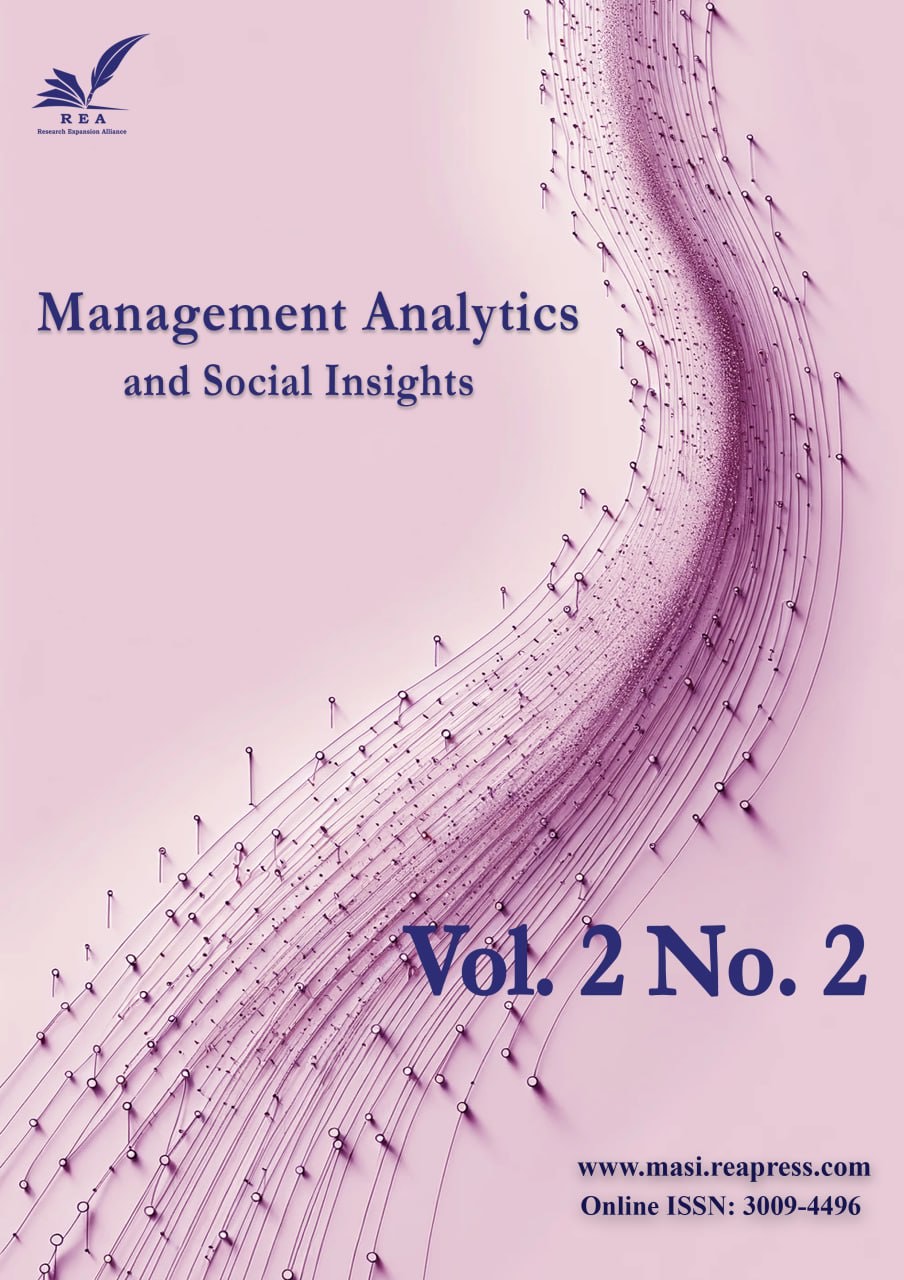A Literature Review on Smallholder Agricultural Finance in Nigeria
Abstract
This study aims to review existing literature on agricultural financing in Nigeria and examine the different financing streams and their effects on smallholder farmers to recommend future research directions to improve the use of these funds for the sustainable development of smallholder farming in Nigeria. The examination of publications found using the following search technique served as the basis for this study: “agricultural,” “finance,” “funding,” or “credit,” “Africa,” and “Nigeria.” The application of contemporary farming technology, the degree of farm production, and the farmers' means of subsistence were the basis for designing a framework for assessing the demand for smallholder agricultural financing in Nigeria. In this study, the term “agricultural financing” concerns smallholder farmers' supply of loans for agricultural operations. Although funding for Nigeria's smallholder farming sector has been reported in several reviewed literature, it is unclear how these funds will affect farm productivity, the use of modern farming technology, and the farmers' standard of living. This study found that there are limited studies conducted on the assessment of financing in the agricultural sector especially in Nigeria.
Keywords:
Agricultural finance, Agricultural credit, Agricultural finance impact, Smallholder farmersReferences
- [1] Kersten, R., Harms, J., Liket, K., & Maas, K. (2017). Small firms, large impact? A systematic review of the SME finance literature. World development, 97, 330–348. https://doi.org/10.1016/j.worlddev.2017.04.012
- [2] Nations, U. (2015). We can end poverty-millenium development goals and beyond 2015. https://B2n.ir/gy6203
- [3] Jones, A. D., & Ejeta, G. (2016). A new global agenda for nutrition and health: The importance of agriculture and food systems. Bulletin of the world health organization, 94(3), 228. https://doi.org/10.2471/BLT.15.164509
- [4] Adeniran, A. O., Akanbi, O. M., & Sidiq, O. B. (2019). Strategy for agricultural intensification in Nigeria: Emphasis on agricultural aviation. International educational scientific research journal, 5(6), 32–36. https://B2n.ir/kh2623
- [5] Marris, P. (2018). Dilemmas of social reform: Poverty and community action in the United States. (2nd Ed.) Routledge. https://doi.org/10.4324/9780203793282
- [6] Bank, W. (2014). World Bank staff estimates based on the united nations population divisions world urbanization prospects. https://data.worldbank.org/indicator/SP.URB.TOTL
- [7] Olaniyia, A. A., & Mojeedb, A. O. (2019). Agricultural aviation a strategy for sustainable food production in Nigeria-lessons from Brazil. American journal of transportation and logistics, 2(11), 2637-6172. https://B2n.ir/rq2708
- [8] Bank, W. (2016). Population growth (annual %). https://B2n.ir/dg7989
- [9] Fadeyi, O. A. (2018). Smallholder agricultural finance in Nigeria: Literature review on the research gap. International journal of new technology and research, 4(8), 26–33. https://B2n.ir/tu8206
- [10] Röttger, D. (2015). Agricultural finance for smallholder farmers: Rethinking traditional microfinance risk and cost management approaches (Vol. 11). Columbia University Press. https://B2n.ir/zn1134
- [11] Miller, C., Jones, L. (2010). Agricultural value chain finance. FAO and Practical Action Publishing. https://www.fao.org/4/i0846e/i0846e.pdf
- [12] Olomola, A. S. (2010). Agricultural finance. Nigeria in, 51–62.
- [13] Adeniran, A. O., & Oladun, E. A. (2020). The implication of transport development models on agricultural development in Nigeria: An empirical review. Open journal of economics and commerce, 3(2), 28–41. http://dx.doi.org/10.22259/2638-549X.0302004
- [14] Adeniran, A. O., Oyeniran, G. T., Adeniran, A. A., & Mosunmola, M. J. (2024). Digitization in logistics and its effect on sustainability in Nigeria, 60(334), 1–11. http://creativecommons.org/licenses/by/4.0/
- [15] Adeniran, A. O., Sidiq, O. Ben, Oyeniran, G. T., & Adenira, A. A. (2024). Sustainability impact of digital transformation in E-commerce logistics. International journal of innovation in marketing elements, 4(1), 1–18. https://doi.org/10.59615/ijime.4.1.1
- [16] IFC. (2011). Scaling up access to finance for agricultural SMEs policy review and recommendations (English). https://B2n.ir/db7690
- [17] Ejiogu, A. O. (2018). Agricultural finance and opportunities for investment and expansion. IGI Global. https://doi.org/10.4018/978-1-5225-3059-6
- [18] Dercon, S., & Gollin, D. (2014). Agriculture in African development: Theories and strategies. Annu. rev. resour. econ., 6(1), 471–492. https://doi.org/10.1146/annurev-resource-100913-012706
- [19] Diao, X., & McMillan, M. (2018). Toward an understanding of economic growth in Africa: A reinterpretation of the Lewis model. World development, 109, 511-522. https://doi.org/10.1016/j.worlddev.2016.12.008
- [20] Olajide, O. T., Akinlabi, B. H., & Tijani, A. A. (2012). Agriculture resource and economic growth in Nigeria. European scientific journal, 8(22), 103–115. https://B2n.ir/xf3959
- [21] Mohamed, A. A., Rangkakulnuwat, P., & and Paweenawat, S. . (2016). Decomposition of agricultural productivity growth in Africa". African journal of economic and management studies, 7(4), 497–509. https://doi.org/10.1108/AJEMS-02-2015-0019
- [22] Iwuchukwu, J. C., & Igbokwe, E. M. (2012). Lessons from agricultural policies and programmes in Nigeria. JL pol’y & globalization, 5, 11. https://core.ac.uk/download/pdf/234649564.pdf
- [23] Adesina, A. (2013). Why agriculture Is Nigeria’s new oil. https://B2n.ir/gp7583
- [24] Evbuomwan, G. O. (2016). Financing agriculture for sustainable economic development. Bullion, 40(3), 2. https://dc.cbn.gov.ng/bullion/vol40/iss3/2/
- [25] Adeniran, A. O., & Tayo-Ladega, O. T. (2024). Understanding literature review As a research method. American international journal of humanities, arts and social sciences, 6(1), 26–35. https://doi.org/10.46545/aijhass.v6i1.333
- [26] Cooper, H. (2009). Research synthesis and meta-analysis: A step-by step approach. (Applied social research methods) (5th Ed.) Sage Publications. https://B2n.ir/df5981
- [27] Gelsomino, L. M., Mangiaracina, R., Perego, A., & Tumino, A. (2016). Supply chain finance: A literature review. International journal of physical distribution & logistics management, 46(4). https://doi.org/10.1108/IJPDLM-08-2014-0173
- [28] Afolabi, J. A. (2010). Analysis of loan repayment among small scale farmers in Oyo state, Nigeria. Journal of social sciences, 22(2), 115–119. http://dx.doi.org/10.1080/09718923.2010.11892791
- [29] Taiwo, J. N., &, & Olurinola, I. O. (2016). Demand and utilization of microloan among micro-entrepreneurs in Nigeria. International journal of economics, commerce and management united kingdom, 4(6), 275–376. https://ijecm.co.uk/wp-content/uploads/2016/06/4617.pdf
- [30] Famogbiele, A. (2013). The challenges of agricultural finance in Nigeria: Constraints to sustainable agricultural and economic revival. International journal of business and social research, 3(5), 234–244. https://doi.org/10.18533/ijbsr.v3i5.22
- [31] Okoro, F. N., & Nwali, N. I. (2017). Agricultural funding and challenges of deposit money banks in Nigeria. Arabian journal of business and management review, 7(5), 1–9. https://B2n.ir/ws8245
- [32] Coker, A. A., & Audu, M. K. (2015). Agricultural micro-credit repayment performance: Evidence from minna microfinance bank, Nigeria. African journal of agricultural research, 10(9), 877–885. https://doi.org/10.5897/AJAR2014.9392
- [33] Ayadi, O. F., Hyman, L. M., & Williams, J. (2008). The role of community banks in economic development: A Nigerian case study. Savings and development, 159–173. https://www.jstor.org/stable/25830975
- [34] Orebiyi, J. S., Eze, C. C., Henri-Ukoha, A., Akubude, F. C., & Ibitoye, S. J. (2011). Demand for institutional credit from the NACRDB by small scale farmers in Imo state, Nigeria. International journal of agricultural science, research and technology (IJASRT), 1(2), 83–87. https://B2n.ir/tn7342
- [35] Omorogiuwa, O., Zivkovic, J., & Ademoh, F. (2014). The role of agriculture in the economic development of Nigeria. European scientific journal, 10(4), 1857–7431. https://core.ac.uk/download/pdf/328024089.pdf
- [36] Tersoo, P. (2014). Agribusiness as a veritable tool for rural development in Nigeria. International letters of social and humanistic sciences, 14(03), 26–36. https://www.ceeol.com/search/article-detail?id=168567
- [37] Falola, A., Ayinde, O. E., & Agboola, B. O. (2013). Willingness to take agricultural insurance by cocoa farmers in Nigeria. International journal of food and agricultural economics (IJFAEC), 1(1), 97–107. http://dx.doi.org/10.22004/ag.econ.156837
- [38] Central Bank OF Nigeria. (2018). Development finance: Agricultural credit. https://www.cbn.gov.ng/out/2019/rsd/2018 ar kama1.pdf
- [39] Hartarska, V., Nadolnyak, D., & Shen, X. (2015). Agricultural credit and economic growth in rural areas. Agricultural finance review, 75(3), 302–312. https://doi.org/10.1108/AFR-04-2015-0018
- [40] Fløgstad, C., & Hagen, R. J. (2017). Aid dispersion: Measurement in principle and practice. World development, 97, 232–250. https://doi.org/10.1016/j.worlddev.2017.04.022
- [41] Chukwuma Sr, C. (2014). Convergence of the Nigerian food and agricultural crisis on sustainable development. Journal of agricultural extension and rural development, 6(2), 61–68. https://doi.org/10.5897/JAERD11.156
- [42] Okotie, S. (2018). The Nigerian economy before the discovery of crude oil. In The political ecology of oil and gas activities in the nigerian aquatic ecosystem (pp. 71–81). Elsevier. https://doi.org/10.1016/B978-0-12-809399-3.00005-7
- [43] Bank, A. D. (2015). African economic outlook 2015 Regional development and spatial inclusion: Regional development and spatial inclusion. OECD Publishing. https://B2n.ir/un3187
- [44] Mogues, T., & Dillon, A. D. A. (2018). Nigeria agriculture public expenditure review (NAGPER) and planned research on agricultural subsidies and the health-productivity nexus. International food policy research institute, 7. https://hdl.handle.net/10568/161969
- [45] Ofoegbu, D. I. (2015). A review of the federal government 2015 budget proposal retrieved, from Centre for Social Justice. https://B2n.ir/jn4631
- [46] Adeniran, A. O., & Sidiq, B. O. (2018). Economic recession and the way-out: Nigeria as case study. Global journal of human social science, 18(1), 181–192. https://B2n.ir/hy4352
- [47] National Bureau of Statistics. (2017). Nigerian gross domestic product report (expenditure and income approach). https://B2n.ir/db4897
- [48] Trading Economics. (2018). Nigeria-employment in agriculture (% of Total Employment). https://B2n.ir/bm1900
- [49] World Bank National Accounts Data. (2018). GDP growth (annual %) - Nigeria. https://B2n.ir/qn9594
- [50] National Bureau of Statistics. (2007). National agricultural sample census pilot (private farmer) livestock and poultry 2007 round 2. https://microdata.worldbank.org/index.php/catalog/6383
- [51] Yahaya, K. A., Osemene, O. F., & and Abdulraheem, A. (2011). Effectiveness of microfinance banks in alleviating poverty in Kwara state Nigeria. Global journal of management and business research, 11(4). https://B2n.ir/xr3583
- [52] Bezemer, D., & Headey, D. (2008). Agriculture, development, and urban bias. World development, 36(8), 1342–1364. https://doi.org/10.1016/j.worlddev.2007.07.001
- [53] Hon. Minister, Budget & National Planning. (2018). Overview of the 2013-2018 budget proposal. https://B2n.ir/tu8361
- [54] Central Bank of Nigeria. (2017). Financial Stability Report - June 2017. https://www.cbn.gov.ng/Out/2018/FPRD/FSR June 2017.pdf
- [55] Eluhaiwe, P. N. (2014). Agriculture and finance in nigeria: Experiences and lessons. Central Bank of Nigeria. https://slideplayer.com/slide/5827462/
- [56] Pardey, P. G., Chan-Kang, C., Dehmer, S. P., & Beddow, J. M. (2016). Agricultural R &D is on the move. Nature, 537(7620), 301–303. https://doi.org/10.1038/537301a
- [57] (OECD), O. for E. C. and D. (2018). Official development assistance (ODA) flows for DAC and non-DAC members, recipients, and regions as interactive summary charts for total DAC, DAC and non-DAC members. https://B2n.ir/hh9937
- [58] International Fund for Agricultural Development (IFAD). (2018). IFAD operations: Nigeria. Retrieved from international fund for agricultural development. https://www.ifad.org/en/
- [59] Gbandi, E. C., & Amissah, G. (2014). Financing options for small and medium enterprises (SMEs) in Nigeria. European scientific journal january, 10(1), 14. https://ssrn.com/abstract=3868198
- [60] Adeniran, A. O., Muraina, J. M., Ilugbami, J. O., & Adeniran, A. A. (2023). Government policy: Meaning, types, manifestations, theories, and policy cycles. Insights into regional development, 5(2), 83–99. https://doi.org/10.9770/ird.2023.5.2(6)
- [61] Eze, C. C., Lemchi, J. I., Ugochukwu, A. I., Eze, V. C., Awulonu, C. A. O., & Okon, A. X. (2010). Agricultural financing policies and rural development in nigeria. The 84th annual conference of the agricultural economics society. AgEcon Serach. http://dx.doi.org/10.22004/ag.econ.91677
- [62] Daneji, M. I. (2011). Agricultural development intervention programmes in Nigeria (1960 to date): A review. Savannah journal of agriculture, 6(1), 101–107. https://B2n.ir/jm5313
- [63] Birthal, P. S., Chand, R., Joshi, P. K., Saxena, R., Rajkhowa, P., Khan, M. T., … Chaudhary, K. R. (2017). Formal versus informal: Efficiency, inclusiveness and financing of dairy value chains in Indian Punjab. Journal of rural studies, 54, 288–303. https://doi.org/10.1016/j.jrurstud.2017.06.009
- [64] Ndikumana, L., & Pickbourn, L. (2017). The impact of foreign aid allocation on access to social services in sub-Saharan Africa: The case of water and sanitation. World development, 90, 104–114. https://doi.org/10.1016/j.worlddev.2016.09.001
- [65] Adesugba, M. A., & Mavrotas, G. (2016). Delving deeper into the agricultural transformation and youth employment nexus: The Nigerian case. https://ideas.repec.org/p/fpr/nsspwp/31.html
- [66] Eicher, C. K. (2004). Flashback: Fifty years of donor aid to African agriculture. New partnership’s for African development. https://B2n.ir/ty5788
- [67] Gomera, M. (2025). Africa doesn’t need aid. It needs control over its critical minerals. https://B2n.ir/gx4331
- [68] The Economist. (2025). Why some Africans see opportunity in foreign-aid cuts. https://B2n.ir/xh6460
- [69] Diallo, M. (2025). Many across Africa shocked by 90-day freeze on US aid. https://B2n.ir/yt3040
- [70] Opalo, K. (2025). African countries must urgently start the process of ending aid dependency. https://B2n.ir/fz5379
- [71] Essien Gloria, A. (2025). UN assistant secretary-general lauds Nigeria’s $200m healthcare allocation. https://von.gov.ng/category/africa/page/2/


